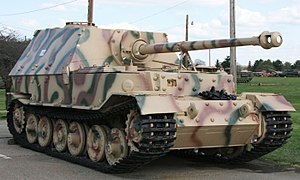
Back إيليفانت Arabic Ferdinand (Tank) Azerbaijani Елефант Bulgarian Elefant (caçatancs) Catalan Ferdinand (stíhač tanků) Czech Elefant (panserjager) Danish Panzerjäger Tiger (P) German Elefant Spanish Elefant Estonian الفانت Persian
| Panzerjäger Tiger (P) | |
|---|---|
 Restored Elefant at the United States Army Ordnance Training and Heritage Center | |
| Type | Heavy tank destroyer |
| Place of origin | Nazi Germany |
| Production history | |
| Designer | Ferdinand Porsche |
| Designed | 1942–1943 |
| Manufacturer | Nibelungenwerk |
| Produced | March–May 1943 (substantial upgrades in January to April 1944) |
| No. built | 91[1] |
| Specifications | |
| Mass | 65 tonnes (143,000 lb) |
| Length | 8.14 m (26 ft 8 in) with gun |
| Width | 3.38 m (11 ft 1 in) |
| Height | 2.97 m (9 ft 9 in) |
| Crew | 6 (driver, radio-operator, commander, gunner, two loaders) |
| Armor | 200 mm (7.87 in) maximum |
Main armament | 8.8 cm Pak 43/2 L/71, also known as StuK 43/1 |
Secondary armament | 7.92 mm MG 34 machine gun (Elefant only) |
| Engine | 2 × Maybach HL120 TRM petrol 600 PS (592 hp, 442 kW) |
| Power/weight | 9.2 PS (6.8 kW) / tonne |
| Suspension | longitudinal torsion-bar |
| Fuel capacity | 950 liters |
Operational range | 150 km (93 mi) road 90 km (56 mi) cross-country |
| Maximum speed | 30 kilometres per hour (19 mph) |
Elefant (German for "elephant") was a heavy tank destroyer (self propelled anti-tank gun) used by German Panzerjäger (anti-tank units) during World War II. Ninety-one units were built in 1943 under the name Ferdinand (after its designer Ferdinand Porsche) using VK 45.01 (P) tank hulls which had been produced for the Tiger I tank before the competing Henschel design had been selected.
Following their use at the battle of Kursk, in January to April 1944 the surviving Ferdinands received modifications and upgrades. They were renamed Elefant in May 1944. The official German designation was Panzerjäger Tiger (P)[Note 1] and the ordnance inventory designation was Sd.Kfz. 184.
- ^ Jentz, Thomas (1997a). Panzerkampfwagen VI P (Sd.Kfz.181). The History of the Porsche Typ 100 and 101 also known as the Leopard and Tiger(P). Darlington Productions. p. 54. ISBN 1892848031.
Cite error: There are <ref group=Note> tags on this page, but the references will not show without a {{reflist|group=Note}} template (see the help page).
© MMXXIII Rich X Search. We shall prevail. All rights reserved. Rich X Search